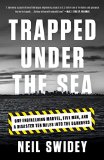Summary | Excerpt | Reviews | Beyond the book | Read-Alikes | Genres & Themes | Author Bio
One Engineering Marvel, Five Men, and a Disaster Ten Miles Into the Darkness
by Neil Swidey

Critics' Opinion:
Readers' Opinion:
First Published:
Feb 2014, 432 pages
Paperback:
Feb 2015, 432 pages
 Book Reviewed by:
Book Reviewed by:
Poornima Apte
Buy This Book
In 2010, The New York Times ran a splashy story about Boston's new waterfront in its Travel section. Complete with slideshow, the article showed what residents have known for a while now - the complete and glamorous revitalization of downtown thanks to two massive engineering projects, The Big Dig and the Harbor cleanup. Looking at the city now, it's hard to imagine that, less than 20 years ago, downtown was nothing more than a set of highways crisscrossing each other, and the harbor was so polluted that it was often described as a cesspool.
Through the '80s and '90s, years of dumping lightly treated sewage lead to a harbor so polluted that the organic matter from the decay had settled on the sea floor creating an oozing mud known as "black mayonnaise." A lawsuit forced the city's hand and the Boston harbor cleanup got underway.
The solution was an expensive cleanup project, the cornerstone of which is the Deer Island treatment plant. At this facility, sewage is treated through a variety of steps until it is clean enough to be released deep into the harbor waters. A complex system of pipes deep under the ocean floor makes sure that this final dispersal is done both far enough away from the city, and with minimum disruption to the environment. A ten-mile long pipe takes care of the first condition - it transports the effluent far enough out to sea. Now, to decrease the environmental impact, a series of 55 additional diffuser pipes branch out at the very end of this mother pipe.
According to Neil Swidey, author of Trapped Under the Sea:
The setup of the tunnel and those risers was something like a water main running underneath a neighborhood street, with a bunch of smaller pipes shooting out from it, each one delivering a portion of the water supply to a different house. When everything was completed, the horizontal tunnel would connect with those fifty-five vertical risers, which would each extend from tunnel depth, up through the bedrock, finally punching the ocean floor. At the point where each riser poked through the seafloor, it would be topped with a mushroom-shaped discharge port, a domed contraption known as a diffuser head. After exiting the Deer Island plant, the treated sewer water would flow along the main tunnel, up through one of those fifty-five riser pipes, out through sprinkler nozzles on one of those fifty-five diffuser heads, and finally out into the ocean. The intricate process was designed to slow down and spread out the flow of the wastewater, 'diffusing' it in an effort to limit its impact on marine life and water quality.
While deep-sea commercial construction takes place all over the world, Swidey shows us how this Boston harbor project was uniquely dangerous:
Imagine you are venturing into a tunnel that's been bored into the bedrock underneath the ocean and that continues straight out, hundreds of feet below the seafloor, for almost ten miles. There is no light, besides the faint glow coming from the bulb on your helmet. There is no sound, besides the water dripping overhead or sloshing around your boots. Most important, there is no breathable air, besides what you brought in with you, a lifeline pumping through a hose and into your facemask. At the end of the tunnel, you don't even have enough room to stand up straight, since it chokes down to just five feet in diameter before ending abruptly. It's the world's longest dead-end tunnel, so there's no way out other than turning around and making the hazardous trek to where you started. For perspective, consider that the deepest ocean point on earth, the Challenger Deep valley in the Pacific Ocean's Mariana trench, lies 6.8 miles below the surface of the water - a distance nearly three miles less than the Deer Island tunnel's total length. Granted the character of Challenger Deep's remoteness is vertical, and the tunnel is mostly horizontal. But because of the tunnel's forbidding conditions, its endpoint effectively makes it farther from the surface than the base of that trench.
Under conditions this extreme, routine commercial deep-sea diving techniques don't hold much water.
A project of this scale was relatively untested ground for the construction companies that took it on. Work on this underwater system of pipes was done in many phases, all of which went smoothly, until the very last one. This final step was the most complex because it was carried out in each of the small dead-end diffuser pipes. The utilities, such as lighting and ventilation, which had served previous workers well, had been cleared out. Worse, by this time, time and money had pretty much run out. This dangerous combination meant that the ad hoc solution that was eventually devised was not vetted thoroughly. As Boston Globe reporter Swidey riventingly shows, fatal mistakes were made, most crucially by supplying untested breathing apparatus to the divers. All these factors combined to create a perfect storm. It is no secret that two of the five divers who went in on July 21, 1999, did not make it. But this account occupies our interest by showing exactly how a series of relatively small errors lead to fatal flaws.
Swidey, a reporter for The Boston Globe, intermixes engineering details and descriptions of the harrowing work along with stories from the workers' colorful lives. The technical details are presented in a lucid style, easy enough for a non-technical reader to understand (well-illustrated diagrams help). While Swidey's narrative (which took years to research) pays generous attention to the divers and their personal backgrounds, these wide-eyed back stories sometimes teeter on the edge of reading like cloying made-for-TV material.
In the end though, this detailed - if occasionally melodramatic - account emerges as a stellar example of quality reporting. While most assumed that the deaths of two construction workers in such a massive project was collateral damage, Swidey suspected they could have been prevented. His inquiry proved his suspicion right - it shines light on just how easy it is to let errors slip when a long-elusive goal is just tantalizingly within reach. Why did this accident happen? "Whenever a worker dies there is a natural inclination to hunt for a huge, single failure that can be blamed. In reality, a worker's death is usually caused by a series of small, bad decisions made by many individuals, none of which, on its own, would have been enough to produce a fatality," Swidey writes. "Disaster strikes only when all the holes in the Swiss cheese line up. But the fact that all these holes did line up in the tunnel case forces a larger, lingering question. How could this idea of sending divers to a place as remote as the moon, asking them to entrust their lives to an improvised, untested breathing system, have ever made sense to sensible people? The answer lies in the dangerous cocktail of time, money, stubbornness, and frustration near the end of the over-budget, long delayed job."
Swidey reminds us that the true heroes are the ones who labor away from the glare of the spotlight, the many workers who keep our engines oiled and the system functioning smoothly every day. This narrative of an engineering project gone awry in Beantown promises to be engaging reading for everyone. After all, no one city owns the monopoly on human error, arrogance and frailty. This utterly preventable tragedy might have happened in Boston but its lessons apply everywhere, to every endeavor large or small. As Trapped Under the Sea successfully shows, the devil does lie in the details.
Additional Information
You can find out more about the project on the book's website, including pictures of the tunnels and the experimental breathing system.
![]() This review was originally published in The BookBrowse Review in March 2014, and has been updated for the
March 2015 edition.
Click here to go to this issue.
This review was originally published in The BookBrowse Review in March 2014, and has been updated for the
March 2015 edition.
Click here to go to this issue.

If you liked Trapped Under the Sea, try these:

by Sheri Fink
Published 2016
Pulitzer Prize winner Sheri Fink's landmark investigation of patient deaths at a New Orleans hospital ravaged by Hurricane Katrina and suspense-filled portrayal of the quest for truth and justice.

by Mark Miodownik
Published 2015
An eye-opening adventure deep inside the everyday materials that surround us, from concrete and steel to denim and chocolate, packed with surprising stories and fascinating science.





The House on Biscayne Bay
by Chanel Cleeton
As death stalks a gothic mansion in Miami, the lives of two women intertwine as the past and present collide.

The Flower Sisters
by Michelle Collins Anderson
From the new Fannie Flagg of the Ozarks, a richly-woven story of family, forgiveness, and reinvention.

The Funeral Cryer by Wenyan Lu
Debut novelist Wenyan Lu brings us this witty yet profound story about one woman's midlife reawakening in contemporary rural China.
Your guide toexceptional books
BookBrowse seeks out and recommends the best in contemporary fiction and nonfiction—books that not only engage and entertain but also deepen our understanding of ourselves and the world around us.